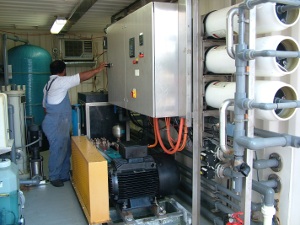 Pacific island countries will continually be challenged to develop and maintain a sustainable and economically viable supply of fresh water.
Pacific island countries will continually be challenged to develop and maintain a sustainable and economically viable supply of fresh water.
The island nations have traditionally been dependant on ground and surface water as well as rainfall as their primary source of supply.
This is still true today, but increased population growth, economic development and irregular rainfall caused by changing weather patterns as well as climate change have placed a tremendous strain on these traditional water supply sources, according to the SPC, Applied Geoscience and Technology Division, Deputy Director for Water and Sanitation, Marc Overmars.
Greater attention is now being placed on holistic approaches such as Integrated Water Resource Management (IWRM), to optimize water supplies in the region and make more efficient use of available resources.
“But for some of the Pacific island countries the availability of freshwater resources is limited especially on atoll islands such as Kiribati, the Marshall Islands and Tuvalu or raised limestone islands such as Nauru,” said Mr. Overmars.
He said that these islands are frequently affected by periods of drought, often caused by changes in Pacific Ocean temperatures.
“This results in a naturally occurring phenomena known as El Niño and La Niña. During an El Niño or La Niña, the patterns of tropical rainfall are affected and satisfying fresh water demand becomes a continuous challenge.
“For example, the current La Niña conditions are causing below normal rainfall in Kiribati and Nauru forcing the countries to put drought mitigation and response plans in place,” he said.
Some island countries have introduced alternative sources to supplement their water supplies. As an example, Nauru is almost totally dependent on desalination for its freshwater supply.
A recent study undertaken by SOPAC’s drinking water advisor Alan Freshwater, reviewed the use of desalination plants in Pacific island countries as a method to supplement the water supplies, such as in Kiribati, Nauru and Tuvalu or deployed in times of drought such as in the Marshall Islands and Tonga.
The study analysed the many factors that determine the viability of utilizing desalination plants, not least is the cost of producing drinking water due to the high energy and operating expenses (in Kirbati, the desalination costs can be up to 16 times higher than groundwater extraction).
Other considerations include the high investment and maintenance costs and the shortage of trained individuals and spare parts to maintain such systems.
As a result, many of the desalination plants introduced into the region since the l980s and 1990s are no longer working because of operation and maintenance problems.
The Japanese Government has provided a fund of US$66 million for Forum member countries to develop projects to “mitigate the effects of climate change” with the focus on the provision of solar power and desalination plants.
Mr. Overmars said that the choice for desalination should always be made in conjunction with conventional water supplies and much care needs to be taken to address the issues around their sustainability.
“What I believe to be essential is to maximize the use of traditional water sources such as rainwater harvesting before investing in desalination as it should mainly be considered as an option of last resort or be temporarily used in an emergency,” said Mr. Overmars.
CAPTION:
A technician checks the operation of one of the three desalination plants on Nauru.
One of the three desalination plants in Nauru. All work out of containers.





